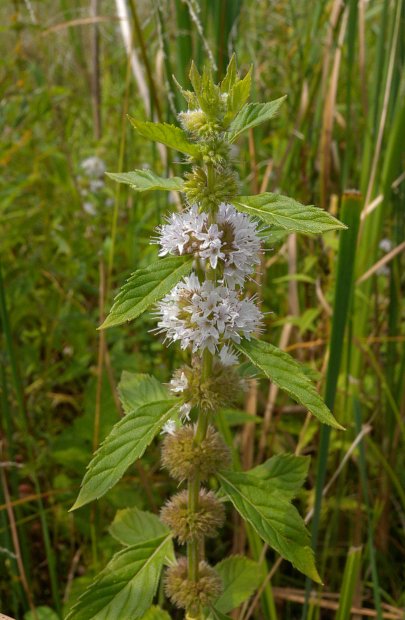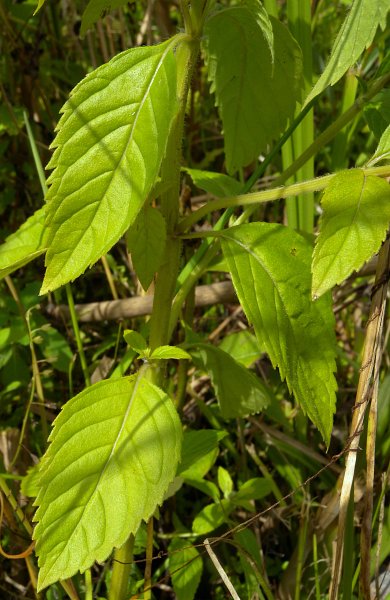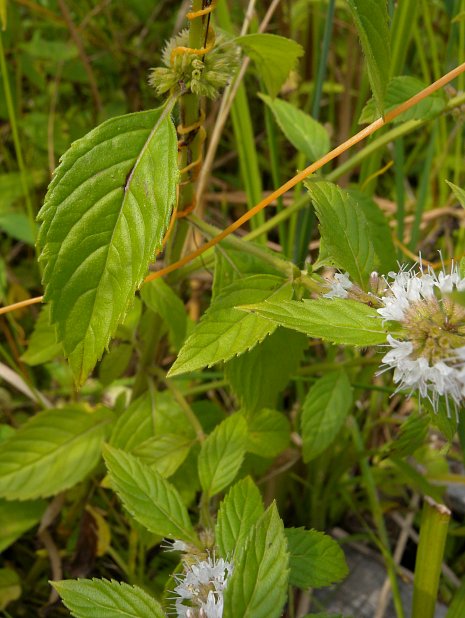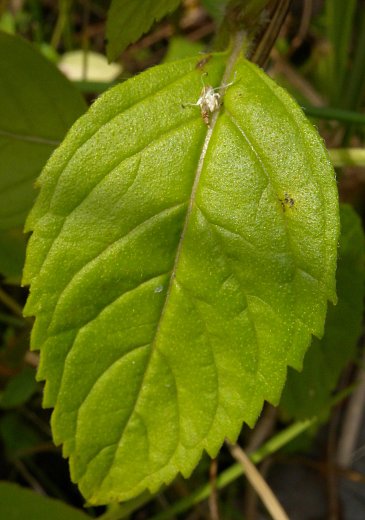Description: Different varieties of this perennial plant exist in both hemispheres. Field Mint is ½–1½' tall, and either erect or having a tendency to sprawl. Generally, the four-angled central stem is hairy or glabrous and little branched. The opposite leaves are 1-2½" long and ½–1" wide, with petioles that are either short or long. The leaves are broadly lanceolate, oblanceolate, or ovate, with conspicuous veins and serrated margins. Their bottoms may be rounded or wedge-shaped, and their may be pubescent or nearly glabrous. The flowers occur in non-terminal whorls above the axils of the upper leaves. They are tubular, with an upper lip that is divided into 2 lobes and a lower lip. Often, the lower lip is subdivided into 3 lobes, although sometimes the flowers are irregular.

Each flower is
about 1/8" long, and may be white, pink, or lavender. They usually
bloom from early to mid-summer for about a month, but sometimes bloom
later. There is no noticeable floral scent, although the foliage exudes
a strong mint fragrance that is often detectable before this plant is
observed. The green calyx has small triangular lobes and it is variably
hairy, depending on the variety. The root system readily produces
rhizomes, forming sizeable colonies.
Cultivation:
The preference is full sun to light shade, and moist conditions with
rich organic soil. This plant likes low-lying open grassy areas. It is
little bothered by disease, and it can spread aggressively.

Range & Habitat: Field Mint occurs primarily in central and northern Illinois, where it is occasional; this species also occurs in scattered counties of southern Illinois (see Distribution Map). The most common variety is Mentha arvensis villosa, which is believed to be native. The typical Eurasian variety also occurs in the same general area, but it is less common. Habitats include edges of marshes, fens, borders of lakes, moist prairies and grassy areas, and miscellaneous waste areas, including landfills. The rhizomes of this plant can survive earth-moving operations and produce new foliage if they remain near the surface of the ground. Field Mint is most often encountered in disturbed areas.

Faunal
Associations:
Primarily flies and wasps visit the flowers for nectar. Other
occasional visitors include small bees, small butterflies, and
skippers. The strong mint fragrance of the foliage usually deters most
mammalian herbivores, although cattle and livestock may consume this
plant along with the grass. It is possible that the anti-bacterial
properties of the floral oil disrupts populations of beneficial
bacteria within the digestive tract of herbivores with multi-chambered
stomachs, causing indigestion. The seeds are too small to be of much
interest to birds.
Photographic Location:
A sandy swale at the Indiana Dunes National Lakeshore in NW Indiana.

Comments: Field Mint can be distinguished from the cultivated mints primarily by its distinct whorls of flowers. According to Mohlenbrock (2002), the native variety of Field Mint, Mentha arvensis villosa, has petioles that are longer than the clusters of flowers and its leaf blades are more wedge-shaped at the base than the typical Eurasian variety, Mentha arvensis arvensis. The hairiness of individual plants is also variable. Field Mint occasionally hybridizes with Mentha spicata (Spearmint) and other mints, producing such hybrids as Mentha × gentilis, Mentha × cardiaca, and others. Many of these hybrids have naturalized in Illinois, preferring similar habitats to Field Mint. Like the cultivated mints, Field Mint can be used to make a pleasant herbal tea. In humans, the floral oil of mints is more likely to disrupt populations of harmful bacteria, reducing flatulence and other digestive problems.